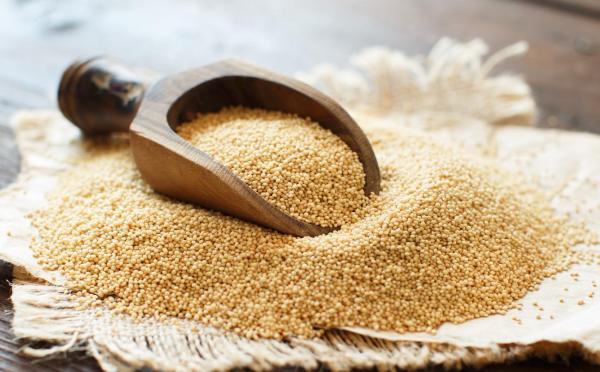Cooking Amaranth - Uses and Benefits


Although not a common ingredient in most kitchens, the amaranth grain is becoming more popular. Native to South America, it was once used regularly by the Aztec civilization and other precolonial nations. It is still used for certain Mexican recipes, but even in this country its usage is limited. Due to its nutritional value, hardiness as a crop and various applications, its status is being reconsidered. We may be more likely to see it sold in a health food shop rather than a supermarket, but as it grows in popularity, its usage is likely to spread also.
At oneHOWTO, we look at the uses and benefits of cooking amaranth, specifically the amaranth grains. We look at its nutritional benefits, as well as how we can prepare amaranth to eat at home.
What is amaranth?
Amaranth the is term for a variety of plants whose seeds are very similar to cereal grains such as wheat, rice or corn. It is these seeds we are discussing when we talk about cooking amaranth. As with other grains such as quinoa, it is considered a pseudocereal. Its consumption is still relatively limited, but it has increased due to its nutritional composition. This includes macronutrients and micronutrients essential for the proper functioning of our body as a whole.
It is a natural source of vegetable proteins since it contains all the essential amino acids we humans need. It also stands out for its high content of antioxidants. These can help fight the action of free radicals, preventing premature aging of our cells. Calcium, magnesium, phosphorus, iron and zinc are some of the minerals it provides. It is also high in B vitamins and provides a good amount of the fiber we need on a daily basis. It is a very complete and nutritious food which has the added benefit of not containing gluten, something suitable for celiacs.
Benefits of cooking amaranth
The nutritional balance of amaranth grain is what makes this such a useful food. For this reason, we can see the benefits of amaranth in the following:
- Amaranth grains contain a considerable amount of carbohydrates. Depending on the variety, it can contain up to 60 g of carbohydrate per 100 g of amaranth. This makes it an ideal energy food for athletes and also for people who engage in intense physical activity. It can still be eaten in moderation by those with more sedentary lives.
- As we have pointed out, the high-protein value makes it advisable to include in a balanced diet, since it helps the condition of our muscles and the general tissues that make up our body. This is especially helpful for vegans and vegetarians who cannot get their protein from animal sources.
- The presence of essential minerals helps to prevent or improve various ailments. Calcium strengthens bones and prevents osteoporosis, Iron makes it a good ally against anemia, as indicated by the Food and Agriculture Organization of the United Nations (FAO)[1] and the presence of magnesium and phosphorus contributes to keeping the body in good condition. It helps boost our immune system and improves our nervous system.
- Amaranth seeds also contain different elements with antioxidant action, especially flavonoids and vitamins A and C essential to avoid oxidative stress and premature cellular aging.
- The fiber provided by the grain (and also the leaves of the plant) helps to keep our gastrointestinal system regular and prevent obesity.
- Fiber also helps maintain good cardiovascular health, being beneficial when it comes to controlling blood cholesterol levels, thanks to the presence of unsaturated fatty acids. It also helps to regulate blood pressure.

Guide to cooking amaranth
It should be clarified amaranth seeds are most commonly consumed in the kitchen, but he leaves of this plant are also used in some countries. They are used similarly as other vegetables such as chard or spinach. If you want to cook the grain, it is really simple. You can prepare it almost the same as any other cereal, such as rice grains. The most common method of cooking amaranth is boiling. To do so, you just have to follow these instructions:
- Measure two and a half cups of water for each one of amaranth grain.
- Place them over medium heat in a saucepan and lower the heat when it starts to boil.
- Hold it until the grain absorbs all the water, about 20 minutes .
- It is convenient to let it rest for a few minutes before using it in the preparation you want.
You can add whatever spices you prefer and use it as a healthy garnish. You can incorporate the grains in salads or combine them with other ingredients, such as quinoa, nuts or even with legumes to obtain a more complete dish.
Side effects of amaranth
In general, amaranth does not present severe side effects. The main exceptions are in cases of allergy or intolerance to this food. Even so, as with any other food, its intake should be moderated as part of a healthy diet.
Eating amaranth excessively could cause its high fiber content to have negative effects, especially in people who suffer from digestive problems or irritable bowel syndrome. In addition, it should be borne in mind that fiber, in principle, is good and promotes proper intestinal transit, but an excessive amount could trigger stomach discomfort or pain and episodes of heartburn, acid reflux or diarrhea.
Now that you know what cooking amaranth is for, you might want to look at other grains you might want to use in your kitchen. This is why we share this article on what are the benefits of wheat bran.
This article is merely informative, oneHOWTO does not have the authority to prescribe any medical treatments or create a diagnosis. We invite you to visit your doctor if you have any type of condition or pain.
If you want to read similar articles to Cooking Amaranth - Uses and Benefits, we recommend you visit our Healthy living category.
- Traditional Crop of the Month. Amaranth. Food and Agriculture Organization of the United Nations (FAO). Retrieved from: https://www.fao.org/traditional-crops/amaranth/en/





